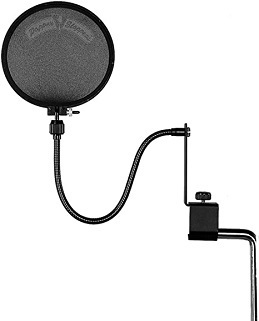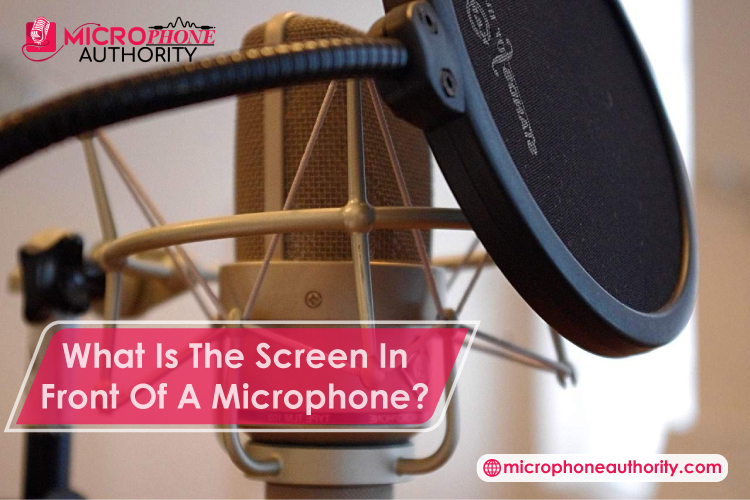Last Updated on May 27, 2023 by Robert Mejia
The screen in front of a microphone is called a pop shield or a pop screen, which acts as noise protection for microphones.
It’s typically used in recording studios and it serves to reduce or rather eliminate the popping sounds caused by fast-moving air during recording.
How the Pop Shield Works
A pop shield is a gadget that acts as a barrier used to shield the microphone from plosive sounds.
How the pop screen works is pretty straightforward, sound passes through the material with small high-recurrence decrease, and nonetheless, plosives end suddenly.
This material mainly permits sound waves through and around; however, it disperses the impacts of air brought about by plosives.
Various designs, such as Shure PS-6 Popper Stopper are made of two mesh layers for the screens to be more useful, separated by a small gap between them.
So that anything that goes past the first layer is withdrawn by the second. Such a Filter will correct even the most exceedingly awful plosives.
However, the windshield must be placed a few inches in front of the microphone.
The impact plosives have on a mouthpiece stomach mainly depends on the distance separating the mouth and receiver. A considerable amount of still air must be present between the pop shield and mic case.

Reasons Why You Should Use a Microphone Pop Shield
A pop filter comes in handy by removing the popping sound that comes from gusts of air from the human voice and outside sources.
The pop shield’s material cover will guard the microphone against any pop overload by distributing the sound as it passes through the screen.
The pop sound spreads rapidly in all directions at the back of the screen, causing it to terminate.
Another reason for possessing a microphone pop filter is to shield the receiver from saliva and food. This less talked about benefit can increase the life span of your amplifiers. Pop filters are a lot simpler to clean or replace than speakers.
Besides, microphones are more likely to get rust after some time, because of spit from the user.
A pop screen will act as a protective wall preventing saliva from accumulating in your mic.
For an essential tool, you may expect that every single pop filter is similar. After getting a microphone, investing in a pop filter isn’t the first thing that rings a bell. However, honestly, since pop filters are quite affordable, it feels significantly more secure to utilize one and afterward not need to stress over getting unwanted sounds on your recordings.
As you get to learn the different ways of recording vocals and getting acquainted with them, you’ll discover precisely how fundamental pop filters can be.
There are various ways to decrease the plosives into the receiver, for instance, by positioning oneself marginally away from your microphone and avoiding breathing directly into the mouthpiece.
When you’re first beginning, it very well may be challenging to find what pop screen works best for you.
You probably won’t comprehend what size or shape works best to go with your mic, or possibly you don’t think a lot about the features that accompany this product.
With a lot of choices on the web, it may be tough making the right decision when selecting pop filters. You must understand the reason why you will be using the screen. Will it be used for a live performance, home rehearsing, or audio recording in the studio? Making this decision will primarily assist in selecting through the many options of filters.
Materials Used to Build Pop Shields.
Whenever we listen to our favorite musicians on our cell phones, it sounds incredible. How they engage, us may seem unbelievable. The most significant factor in accomplishing the smooth and obstruction-free vocals we love to hear is by using a pop screen with your microphone.
Nylon Pop Filters
Woven nylon pop shields are maybe the most commonly known. Even though nylon is the typical material used in texture-style pop channels, other fabrics make small components.
Nylon pop screens are designed with two layers of slim texture firmly fit around the filter fringe, with a little air hole between them. This air hole helps prevent plosives from penetrating the mic.
Metal Alloy Pop Filters
Metal pop filters have gained more popularity lately. The pop filter is a thin sheet of metal with openings strategically designed. These openings divert the air, moving it away from the microphone. With it’s one of a kind material, the Metal pop filter adopts a unique strategy to the issue of popping. As opposed to just blocking plosive sounds, the Filter uses calculated openings within the Filter to divert the force downwards, far away from the microphone. This model is a perfect blend of value and affordability. I would recommend it moreover every other choice.
Benefits of Shure PS-6 Popper Stopper
There’re numerous reasons why you want to purchase a Shure PS-6 Popper Stopper.
This includes:
- They are easily cleaned and dry faster.
- It protects your microphone from saliva; after some time, saliva accumulates on the pop filter, probably creating some smell. A metal pop filter can easily get washed.
- Doesn’t tear like woven nylon filters. If a nylon channel tears, it will not, at this point, be useful for decreasing plosives. The metallic Shure is sturdy and can last for a more extended period.
- Shure PS-6 Popper Stopper also possesses bigger openings permitting more high frequencies compared to the woven nylon filters.





